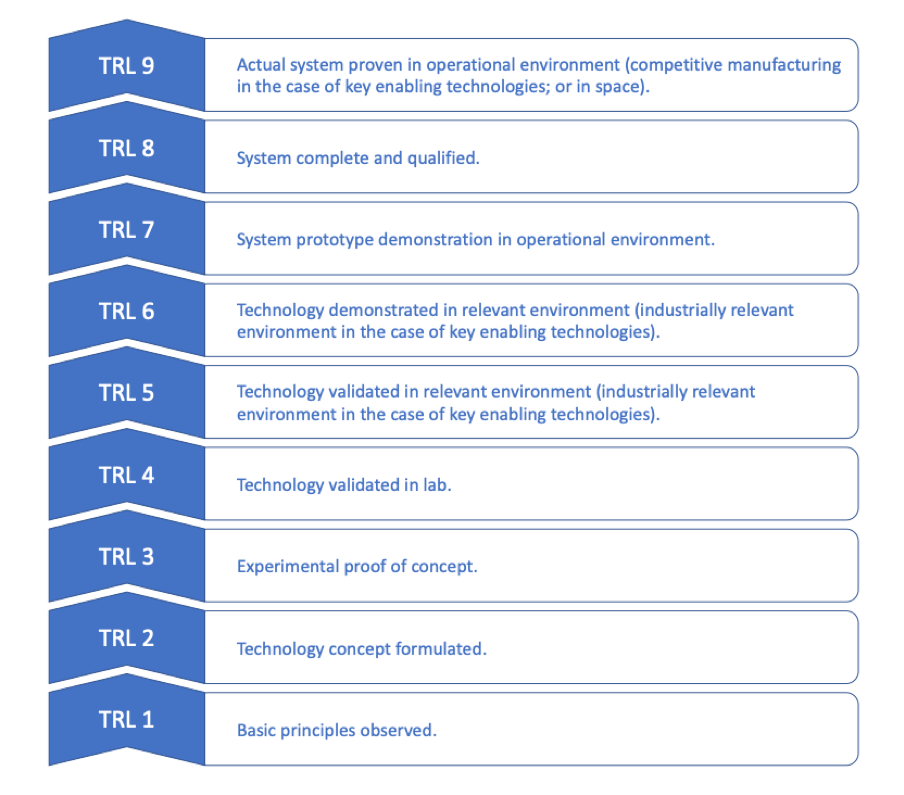Difference between revisions of "Technology Readiness Level"
(Created page with "{| class="wikitable" ! TRL Code ! TRL Description |- |style="background:#f0f0f0;vertical-align:text-top;"| TRL1 |style="background:#f0f0f0;vertical-align:text-top;"| Scientif...") |
|||
| (9 intermediate revisions by the same user not shown) | |||
| Line 1: | Line 1: | ||
| + | NI4OS-Europe onboarding team uses the Technology Readiness Level (TRL) to assess a resource development stage. The figure below illustrates nine different stages that TRL overseas in the process of development. From the on-boarding perspective, only high-level TRLs are of interest, i.e., we will initiate the on-boarding process only for resources with TRL > 7. However, in our portfolio system, we will also collect and describe resources that are currently under development, with TRL < 8. We strongly believe that EOSC could influence the course of the development, and therefore we would like to be able to track the progress of a particular service and inform the developers about EOSC features and functionalities that could be integrated and reused in the early service development stage. For example, it seems that the integration with the AAI could be easier accomplished during the process of development of a service than later, when the service is mature enough and when low-level functionality (such as authentication and authorization) needs to be redesigned. At the early stage, the developers will be able to design the database that contains users' information in a way suitable for integration with external AAI. | ||
| + | |||
| + | [[File:TRL.png|640px|Different technology readiness levels in the process of resource development.]] | ||
| + | |||
{| class="wikitable" | {| class="wikitable" | ||
! TRL Code | ! TRL Code | ||
| Line 4: | Line 8: | ||
|- | |- | ||
| − | |style="background:#f0f0f0;vertical-align:text-top;"| | + | |style="background:#f0f0f0;vertical-align:text-top;"| TRL 1 |
| − | |style="background:#f0f0f0;vertical-align:text-top;"| | + | |style="background:#f0f0f0;vertical-align:text-top;"| Basic principles observed. |
|- | |- | ||
| − | |style="background:#ffffff;vertical-align:text-top;"| | + | |style="background:#ffffff;vertical-align:text-top;"| TRL 2 |
| − | |style="background:#ffffff;vertical-align:text-top;"| | + | |style="background:#ffffff;vertical-align:text-top;"| Technology concept formulated. |
|- | |- | ||
| − | |style="background:#f0f0f0;vertical-align:text-top;"| | + | |style="background:#f0f0f0;vertical-align:text-top;"| TRL 3 |
| − | |style="background:#f0f0f0;vertical-align:text-top;"| | + | |style="background:#f0f0f0;vertical-align:text-top;"| Experimental proof of concept. |
|- | |- | ||
| − | |style="background:#ffffff;vertical-align:text-top;"| | + | |style="background:#ffffff;vertical-align:text-top;"| TRL 4 |
| − | |style="background:#ffffff;vertical-align:text-top;"| | + | |style="background:#ffffff;vertical-align:text-top;"| Technology validated in lab. |
|- | |- | ||
| − | |style="background:#f0f0f0;vertical-align:text-top;"| | + | |style="background:#f0f0f0;vertical-align:text-top;"| TRL 5 |
| − | |style="background:#f0f0f0;vertical-align:text-top;"| | + | |style="background:#f0f0f0;vertical-align:text-top;"| Technology validated in a relevant environment (industrially relevant environment in the case of key enabling technologies). |
|- | |- | ||
| − | |style="background:#ffffff;vertical-align:text-top;"| | + | |style="background:#ffffff;vertical-align:text-top;"| TRL 6 |
| − | |style="background:#ffffff;vertical-align:text-top;"| | + | |style="background:#ffffff;vertical-align:text-top;"| Technology demonstrated in a relevant environment (industrially relevant environment in the case of key enabling technologies). |
|- | |- | ||
| − | |style="background:#f0f0f0;vertical-align:text-top;"| | + | |style="background:#f0f0f0;vertical-align:text-top;"| TRL 7 |
| − | |style="background:#f0f0f0;vertical-align:text-top;"| | + | |style="background:#f0f0f0;vertical-align:text-top;"| System prototype demonstration in an operational environment. |
|- | |- | ||
| − | |style="background:#ffffff;vertical-align:text-top;"| | + | |style="background:#ffffff;vertical-align:text-top;"| TRL 8 |
| − | |style="background:#ffffff;vertical-align:text-top;"| | + | |style="background:#ffffff;vertical-align:text-top;"| System complete and qualified. |
|- | |- | ||
| − | |style="background:#f0f0f0;vertical-align:text-top;"| | + | |style="background:#f0f0f0;vertical-align:text-top;"| TRL 9 |
| − | |style="background:#f0f0f0;vertical-align:text-top;"| | + | |style="background:#f0f0f0;vertical-align:text-top;"| Actual system is proven in an operational environment (competitive manufacturing in the case of key enabling technologies; or in space). |
|} | |} | ||
Latest revision as of 12:28, 6 March 2020
NI4OS-Europe onboarding team uses the Technology Readiness Level (TRL) to assess a resource development stage. The figure below illustrates nine different stages that TRL overseas in the process of development. From the on-boarding perspective, only high-level TRLs are of interest, i.e., we will initiate the on-boarding process only for resources with TRL > 7. However, in our portfolio system, we will also collect and describe resources that are currently under development, with TRL < 8. We strongly believe that EOSC could influence the course of the development, and therefore we would like to be able to track the progress of a particular service and inform the developers about EOSC features and functionalities that could be integrated and reused in the early service development stage. For example, it seems that the integration with the AAI could be easier accomplished during the process of development of a service than later, when the service is mature enough and when low-level functionality (such as authentication and authorization) needs to be redesigned. At the early stage, the developers will be able to design the database that contains users' information in a way suitable for integration with external AAI.
| TRL Code | TRL Description |
|---|---|
| TRL 1 | Basic principles observed. |
| TRL 2 | Technology concept formulated. |
| TRL 3 | Experimental proof of concept. |
| TRL 4 | Technology validated in lab. |
| TRL 5 | Technology validated in a relevant environment (industrially relevant environment in the case of key enabling technologies). |
| TRL 6 | Technology demonstrated in a relevant environment (industrially relevant environment in the case of key enabling technologies). |
| TRL 7 | System prototype demonstration in an operational environment. |
| TRL 8 | System complete and qualified. |
| TRL 9 | Actual system is proven in an operational environment (competitive manufacturing in the case of key enabling technologies; or in space). |
